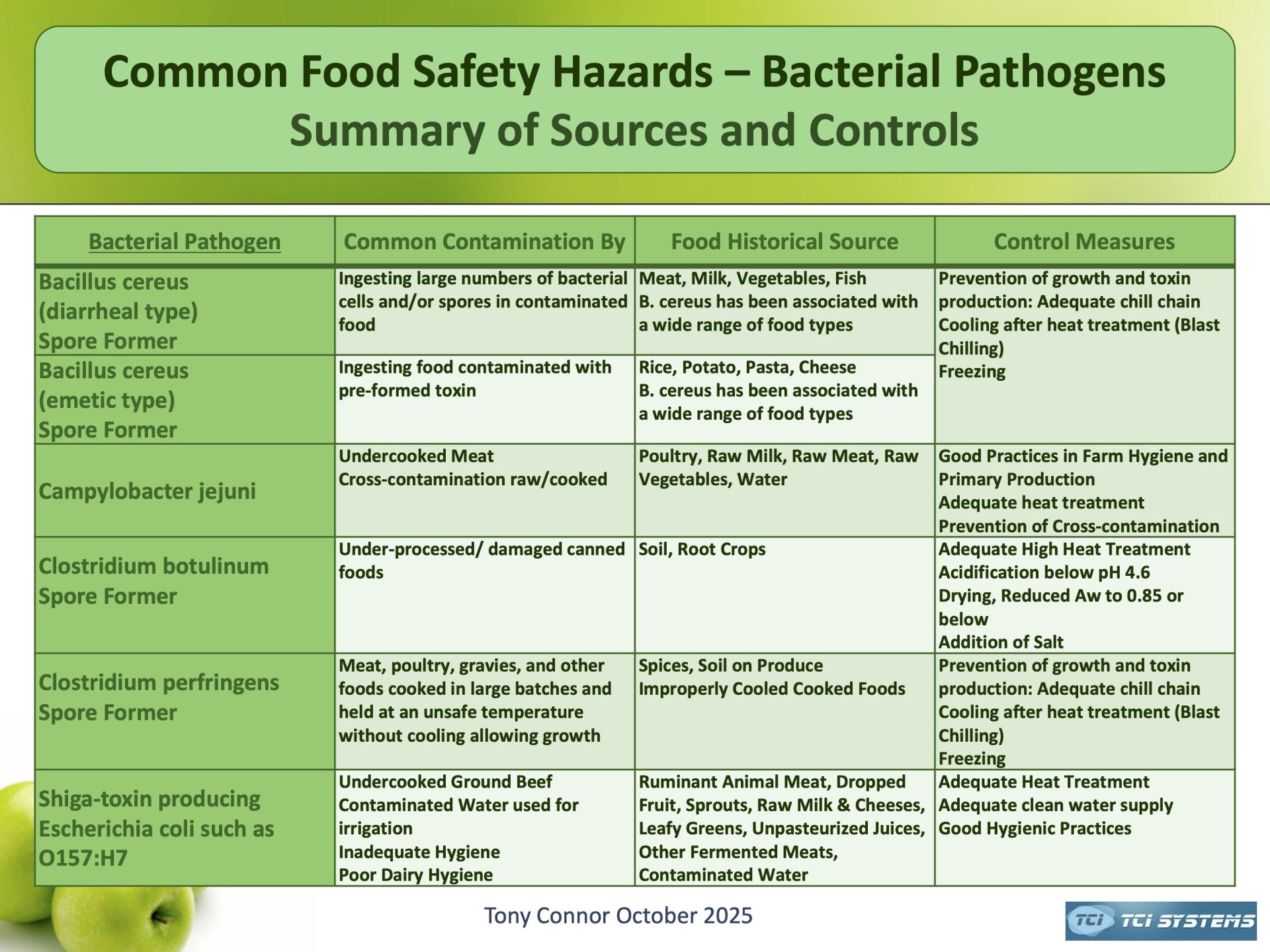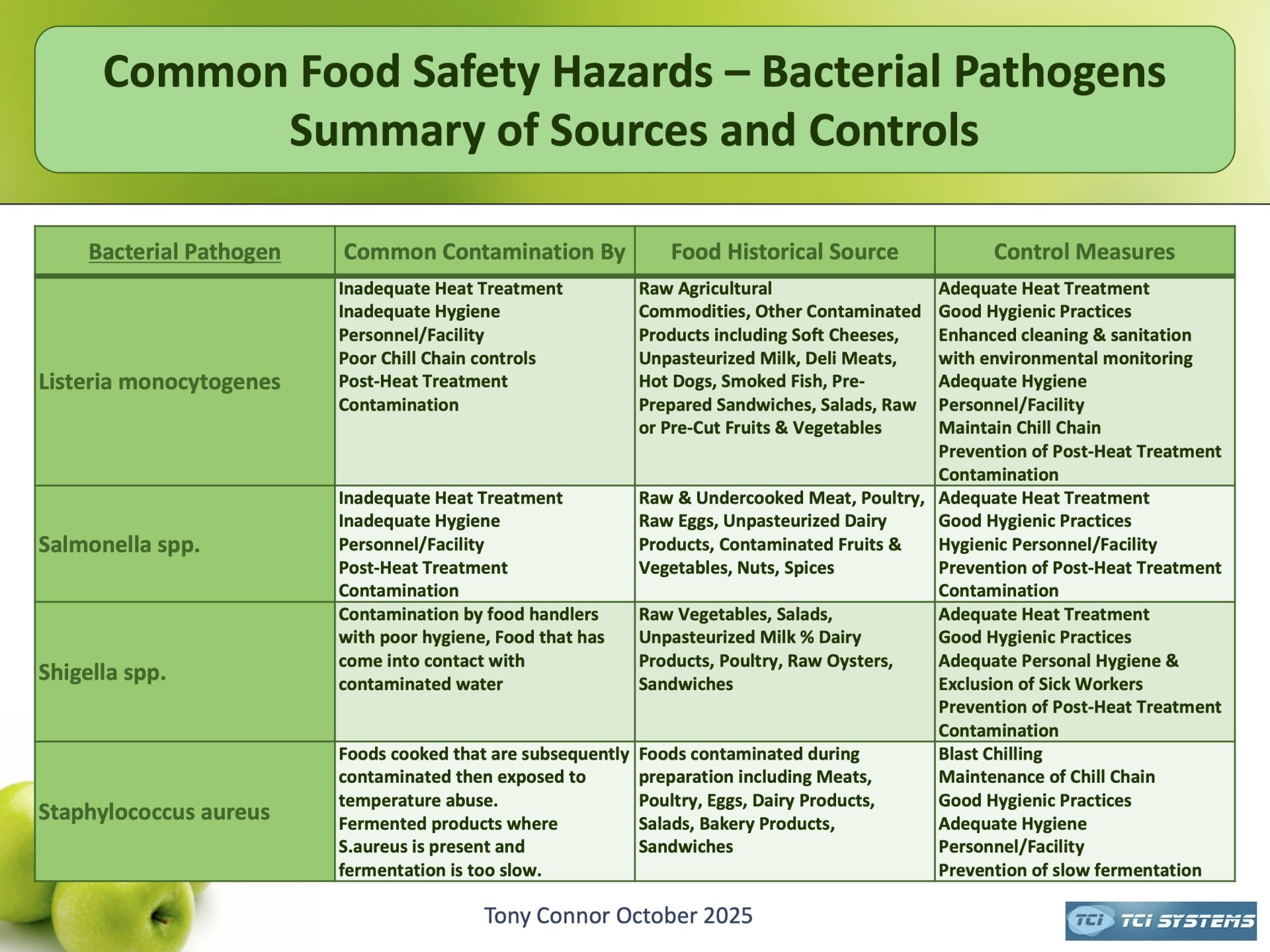Common Food Safety Hazards – Bacterial Pathogens
Welcome to our latest article in our series of blogs providing advice on how to prepare for a food safety audit. In this article, we discuss control of the most common Bacterial Pathogens associated with food which are:
Bacillus cereus (spore former)
Campylobacter jejuni
Clostridium botulinum (spore former)
Clostridium perfringens (spore former)
Shiga-toxin producing Escherichia coli such as O157:H7
Listeria monocytogenes
Salmonella spp.
Shigella spp.
Staphylococcus aureus
Bacillus cereus is a spore former and food poisoning can be caused by either:
Ingesting large numbers of bacterial cells and/or spores in contaminated food (diarrheal type). Sources include Meat, Milk, Vegetables and Fish.
Or Ingesting food contaminated with pre-formed toxin (emetic type). Sources include Rice Products, Potato, Pasta and Cheese Products
Control is achieved by Prevention of growth and toxin production; Adequate chill chain, Cooling after heat treatment (Blast Chilling) or Freezing.
Campylobacter jejuni is the bacterium responsible for campylobacteriosis. Sources include Poultry, Raw Milk, Raw Meat, Raw Vegetables and Contaminated Water. Infection is usually by undercooked meat or cross-contamination between raw & cooked meat, particularly poultry. Symptoms include diarrhea, fever, abdominal pain, nausea, headache, and muscle pain. Symptoms start from 2 to 5 days after consumption of contaminated food and last from 7 to 10 days.
Clostridium botulinum is a bacterium that forms spores that are highly resistant to heat, pressure, and chemicals and can remain in a dormant state until exposed to conditions that support their germination and growth, such as in inadequately processed low-acid canned foods. The bacterium produces a toxin responsible for a severe paralytic illness called botulism which has a high mortality rate. C. botulinum is found in soil and grows best in low oxygen (anaerobic) conditions.
Common sources include Root Crops and any food that has had contact with soil. Control measures include destroying the spores and prevention of growth so Adequate High Heat Treatment, Acidification below pH 4.6, Drying, Reduced Aw to 0.85 or below and the Addition of Salt.
Clostridium perfringens is a heat resistant spore forming bacterium that is responsible for perfringens food poisoning. The bacterium causes illness when large numbers of the bacteria are consumed in contaminated food and then produce enough toxin in the intestines to cause illness.
Causes include a lack of cooling and holding of food at warm temperatures, allowing any spores to germinate and vegetative cells to grow. Typical contaminated foods include Meat, poultry, gravies, and other foods cooked in large batches and held at an unsafe temperature without cooling allowing growth. Sources also include Spices and soil on Produce.
Control measures include prevention of growth so Adequate chill chain, Cooling after heat treatment (Blast Chilling) and Freezing.
Escherichia coli (Pathogenic Strains) are responsible for four types of illness:
Gastroenteritis or infantile diarrhea, caused by enteropathogenic E. coli (EPEC)
Travelers’ diarrhea, caused by enterotoxigenic E. coli (ETEC)
Bacillary dysentery, caused by enteroinvasive E. coli (EIEC)
Hemorrhagic colitis, caused by enterohemorrhagic E. coli (EHEC) – Also known as shiga toxin-producing E. coli with O157:H7 being the most well-known and a common cause of severe illness.
Sources include Ruminant Animal Meat, Dropped Fruit, Sprouts, Raw Milk & Cheeses, Leafy Greens, Unpasteurized Juices, Other Fermented Meats and Contaminated Water. Contamination is caused by Undercooked Ground Beef, Contaminated Water used for irrigation and Inadequate Hygiene. Control measures include Adequate Heat Treatment, Adequate clean water supply and Good Hygienic Practices.
Listeria monocytogenes is the bacterium responsible for listeriosis and produces mild flu-like symptoms in many individuals but it can result in more severe symptoms in susceptible individuals, including pregnant women, newborns, and the immunocompromised. (L. monocytogenes) Mortality Rate is high (approximately 25%) in those that display the more severe symptoms.
Sources include Raw Agricultural Commodities, Other Contaminated Products including Soft Cheeses, Unpasteurized Milk, Deli Meats, Hot Dogs, Smoked Fish, Pre-Prepared Sandwiches, Salads, Raw or Pre-Cut Fruits & Vegetables. Causes include Inadequate Heat Treatment, Inadequate Hygiene Personnel/Facility, Poor Chill Chain controls and Post-Heat Treatment Contamination.
Prevention controls include Adequate Heat Treatment, Good Hygienic Practices, Enhanced cleaning & sanitation with environmental monitoring, Adequate Personal Hygiene Personnel, Hygienic Facility, Maintaining the Chill Chain and Prevention of Post-Heat Treatment Contamination.
Salmonella spp. is the bacterium responsible for salmonellosis. According to the CDC, there are over one million cases of foodborne salmonellosis in the United States every year.
Sources include Raw & Undercooked Meat, Poultry, Raw Eggs, Unpasteurized Dairy Products, Contaminated Fruits & Vegetables, Nuts and Spices. Contamination is by Inadequate Heat Treatment, Inadequate Hygiene Personnel/Facility and Post-Heat Treatment Contamination.
Control is by Adequate Heat Treatment, Good Hygienic Practices, Adequate Personal Hygiene Personnel, Hygienic Facility and Prevention of Post-Heat Treatment Contamination
Shigella spp. is the bacterium responsible for shigellosis. Shigella infections can be caused from eating contaminated food usually through lack of hygiene by infected food handlers or contaminated water.
Associated foods include Raw Vegetables, Salads, Unpasteurized Milk & Dairy Products, Poultry, Raw Oysters and Sandwiches. Controls include Adequate Heat Treatment, Good Hygienic Practices, Adequate Personal Hygiene & Exclusion of Sick Workers and Prevention of Post-Heat Treatment Contamination.
Staphylococcus aureus is a common bacterium that produces toxins as it grows in foods, causing staphylococcal food poisoning. S. aureus is found on the skin and in the noses of many healthy people and animals.
Typical causes of staphylococcal food poisoning include cooked foods that are subsequently contaminated then exposed to temperature abuse and fermented products where S.aureus is present and fermentation has not progressed quickly enough. Sources include foods that are contaminated during preparation including Meats, Poultry, Eggs, Dairy Products, Salads, Bakery Products and Sandwiches.
Prevention measures include Blast Chilling, Maintenance of the Chill Chain, Good Hygienic Practices, Adequate Personal Hygiene & Exclusion of Infected Workers, Prevention of Post-Heat Treatment Contamination and Prevention of slow fermentation.


HACCP 7 Principles Explained – Relevance of Bacterial Pathogens
When carrying out a Hazard Analysis and Assessment we will need to identify any Bacterial Pathogens that are associated with the raw materials and ingredients. It may be that we need to ensure that we have adequate Supplier Approval and Raw Material Verification controls in place to ensure that any Bacterial Pathogens in the raw materials and ingredients are absent or minimized, this is important when there are limits to the subsequent process steps in terms of Bacterial Pathogen reduction.
During Hazard Analysis and Assessment, we also look at the steps in our process to decide where measures need to be applied to control the Bacterial Pathogens. At this stage, we need to understand if the Bacterial Pathogens identified are spore formers or only exist as vegetative cells, as spores that survive a processing step designed to kill vegetative bacteria can become a hazard.
In favorable conditions the spores can germinate and grow as vegetative cells, this is compounded when processing step has removed most of competing bacteria in a food. It means that the targeted Bacterial Pathogen could increase in number over acceptable limits (critical limits for CCPs).
Our Hazard Assessment will need to look at control measures in subsequent steps that can prevent the growth of the Bacterial Pathogen. Time and temperature controls are the most common method of controlling bacterial growth. Steps to control the Bacterial Pathogen after heat treatment include blast chilling which prevents spore growth by rapidly lowering cooked food temperatures from over 70°C (158 F) to a safe temperature of less than 5°C (41 F) within 90 minutes minimizing the time the food spends in “danger zone” (5°C to 68°C) where bacteria and spores multiply rapidly.
Other common controls include product formulation, for example; acidification or reduced pH, reducing water activity (aw) and the addition of preservatives or salt.

